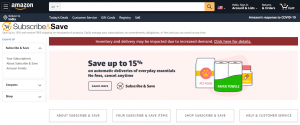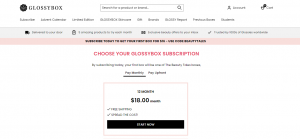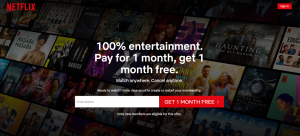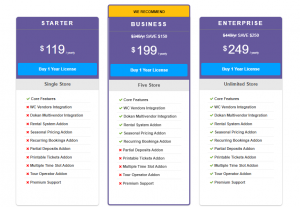Table of Contents
Subscription-based e-commerce models are everywhere around us. Even your daily dose of curated music from Spotify offers subscription plans for their services. And it is also one of the reasons why they are doing so well in today’s time. Spotify’s quarterly revenue in its 2020 Q1 was at $2 billion out of which $1.84 billion was due to Spotify Premium subscribers. That’s almost 90% of the revenue due to their subscribers! So what exactly does the subscription model entail and why does your e-commerce store require one? Let’s have a look.
What is subscription-based e-commerce?
With a subscription-based e-commerce business model, a business allows its customers to subscribe to products or services they require on a regular basis. This is offered in exchange for regular payments from the customers. Subscription can vary according to time-periods such as weekly, monthly, annually, or sometimes even on the basis of customer preference. How cool, right?
Earlier, subscriptions were limited to only magazines and newspapers. But e-commerce is all about innovation and revolutionizing the way in which products and services are perceived, bought, and even sold today. Subscription-based e-commerce models are now being adapted and fully utilized by services that range from the gaming sector to cosmetics. Several niches such as vegan foods or pet foods and even giants like online streaming platforms like Netflix have blossomed because of this model.
Some Ecommerce Subscription Stats
With a valuation of US$ 13.23 billion in 2018, the Global Subscription E-commerce market is currently anticipating reaching US$ 478.2 billion by 2025. If this information is not indicative of the point that subscription-based e-commerce models are the way to go, then let us knock your socks off with a few other facts
- Recent research from Zuora discovered that in 2019, 71% of adults across 12 countries have subscription services. To top it off, 74% believe that in the future, people will tend to shift towards subscription services rather than owning physical goods.
- The future seems even brighter for consumers in the year 2021. This is because a survey conducted by Deloitte suggests that 25% of consumers plan to subscribe to more services.
- According to Manifesto Growth Architect, a growth strategy consultancy, 70% of business leaders across retail, finance, leisure, automotive, and utility industries believe that subscription business models will be the key to their prospects for future growth.
- According to Gartner, the subscription-based model is one of the major things that will impact the future of digital commerce. They predict that by 2023, 75% of organizations selling direct to consumers will offer subscription services.
- For people especially in the UK, the subscription box market will hit 72% by the year 2022!
The three main types of subscription-based models
1. Replenishment subscription model
This model offers regular subscription services for a ready supply of various products. Think of the daily utility products such as food, groceries, razors, or even toiletries. This model caters specifically to such needs. Consumers usually opt for this model because the products that are offered have consistent consumption rates. This is best from a consumer’s perspective because they need not check the price of the product every time they renew the subscription. For example, Amazon’s ‘Subscribe and Save’ option gives a discount of 10% to 15% per subscription if the customer receives products from 5 or more subscriptions in a given month.

2. Curation or the Discovery subscription model
Imagine you receive a box full of presents at regular intervals of time. Every time you open the box, you discover something new inside it. And to add a cherry on top of this, the presents are based on your tastes. Feels just like your birthday, right? And that is exactly what this model is all about.
A curation subscription model’s basic aim is to satisfy the consumer’s unique tastes and preferences by personalizing the products. It caters to the excitement that comes along ‘unboxing’ or ‘discovering’ something new, unique, and fresh each time you subscribe for something! For example, the Glossybox subscription offers 5 new beauty products every month for their customers.

Several on-demand entertainment services such as Netflix and Amazon Prime Video also fall under Curation services because they provide a wide range of entertainment options such as Stand-up comedy, TV shows, and movies all in one place. The subscribers can discover and choose whatever they wish to watch from varied options.

3. Bargain or Access subscription model
In today’s world, who doesn’t like to be treated like royalty? Everybody does and that’s why many businesses are shifting towards making the customer experience more aimed at exclusivity. The Bargain or Access subscription model maintains this by offering their subscribers an exclusive membership that gives them access to lower prices, members-only perks, or first-access deals. For instance, JustFab sells women’s fashion. But for VIP-members, they give up to 30% discount on the retail price of the products.

Perks of running a subscription-based e-commerce model
1. An effortless process for Customers
Customers often complain about how checkout processes are sometimes a hassle-filled affair. With subscription-based e-commerce models, the customers can easily avoid going through the checkout process more than once while opting for a service. Customers love it when they just fill in the details, choose what they need, and set it for the duration they need it for. The whole point is to let customers “set it and forget it”. What’s even better is that customers can choose to opt-out of services without facing any extra charges. Such a process is aimed at a customer’s convenience and it is the best reason why it becomes an easy process for them. Even a survey by Mckinsey&Company suggests that 24% of customers continued their subscription because of the fact that it was convenient for replenishment subscriptions.
2. Keeps hold of your Customers
Everybody’s running a race where they are trying their best to compete against e-commerce giants such as Amazon. But do you know what’s easier? Having no competition! That’s right, with subscription-based e-commerce models, the only competition a buyer faces is competition with themself. This is because subscriptions are retention-based models rather than conversion-models. The major goal is to retain valuable customers. With higher retention, your company gets better business stability over time. Higher retention also makes sure that your customers understand your brand and its valuable services.
Another benefit of the subscription model is that you can increase your revenue by upselling or cross-selling relevant products.
3. Better prediction of future sales, revenue, and inventory
If the sales are recurring, then won’t the financial forecasting become much easier? That’s right, subscription-based e-commerce models improve predictability not only in terms of forecasting your sales and revenue but also in terms of your inventory.
Imagine there are customers subscribing to your services for months in advance, or at least for the duration they opt to choose. This makes it certain to know how many subscribers you have for that time period and also for how long they plan to subscribe to your services. Your total turnover then becomes easier to predict because you know exactly how frequently your items need to be refilled and in what quantity. Controlling and managing your stocks become a breezy task.
The more you think about it, the more benefits this model will give you. Since you can manage your stock well, you can avoid wastage of inventory. Not only this, but you can even save time, efforts, and costs by selecting your vendors in advance.
4. Finally, customers love subscriptions
We’ve already mentioned this but we would like to emphasize again why this model is the best for customers! Subscription-based models are built on the following ideas that are adored by customers –
- Ease
- Convenience
- Lack of burden of choice
- Excitement
- Easy Budgeting
- The anticipation of expecting some new
- Personalized experience
- Exclusivity
- Discounts
- Time-saving process
The crux of this argument remains the same, that is, customers love subscription services and products because they come along with so many benefits.
How to get your subscription-based e-commerce model started
1. Find a powerful Subscription extension for your WooCommerce store
WooCommerce, an open-source WordPress plugin, can help transform your site into a robust e-commerce platform. We recommend this because WooCommerce is free to use on its own, it provides more than 400 integration options and has unlimited products for use. In order to start your e-commerce store with WooCommerce, you can have a look at our ultimate guide here and even take some inspiration from these stores which use WooCommerce.
Now that you know how to build your e-commerce store with WooCommerce, it’s time to think about your marketing and sales goals by looking into subscription extensions and plugins. It does not matter what kind of product you’re selling, you can use various WooCommerce extensions to suit your subscription preferences. One such premium extension is WooCommerce Subscriptions. Another option you can look into is YITH WooCommerce Subscription. Barring these choices that are often used by many e-commerce sellers to achieve their subscription goals, you can most definitely consider other options that suit your goals, needs, and price.
2. Make a note of your niche
Let’s say you want to start your e-commerce store focused around the domain of clothing and fashion. However, can you imagine how many such e-commerce sites already exist today? Perhaps, a lot! But what if you shifted your focus to something smaller within the clothing and fashion industry? Maybe something like lingerie or even handcrafted jewelry? Chances are, your e-commerce business will do much better with a focused niche in mind. That’s because niche products make up around 20% of the overall market. It is therefore of the utmost importance to start thinking about your store in specific terms rather than generic ones. Some of the questions that you should ask before venturing into the subscription model can be along the lines of –
- What kind of audience should my business target?
- What kind of services/products should my business offer?
- Does my business revolve around a specific niche?
- How well is this niche doing currently?
- What are some of the trends or statistics that will help me understand my niche better?
The more critical you are of your business ideas, the more you’re bound to align your business on the right track around a subscription model. Great subscription-based e-commerce models cater to targeting specific audiences and bringing the best of a curated experience to the forefront. Niche products are also one of the trends that will continue for 2020.
3. Find your USP
Now that you’ve found your niche, the next best thing is to look at how your business offers something better than other businesses that are already in the game. How will you set your business apart from others? What will make your business unique from all the others in the industry? Do you have a key factor that will draw your customers right onto your site? If yes, then you’re on the right track to making sure exactly how valuable your products and services are to your customers.
Various factors such as excellent customer service, surprise elements with deals, exceptional curated products, and easy payment and billing options are just some of the reasons why customers find subscription-based services and products valuable. If your business can find or come up with a USP around some of the previously mentioned benefits and provide something of value that no other service in your niche can, then you have higher chances of flourishing with your e-commerce subscription business!
4. Stock up your inventory
Subscription-based e-commerce models have been doing well because they have an added advantage of beforehand knowledge about their inventory. Since the subscriptions are specifically based on a limited duration, keeping a track of your inventory becomes easier. We know this and you know this. But what about when you’re just starting out?
For the ones who are just beginning with their business, it is wise to stock your inventory before you start your marketing or promoting your products. This is because there might be chances that once the word gets out, you might get a lot of subscribers in one go. And when that happens, you don’t want to run out of stock before your business even actually takes off. Hence, it is wise to obtain your products before you get started.
All of this sounds fascinating and I am on board with this model. But what if I’m already running a successful e-commerce business? Is the subscription-model still a viable option for me?
Absolutely yes! You can opt to add a subscription service under your overall operations. However, one extremely crucial thing to remember while doing this is being mindful of how subscription-based e-commerce models would affect your existing customer base. If you’re already running a successful e-commerce company, it’s best to use subscription-based services as a support to enhance the value proposition for your customers. Don’t think of overturning your whole business just so it suits the subscription model. Rather think of it in terms of adding something ‘extra special’ for your customers so that it is easily conveyed how much you value them.
Subscription-based e-commerce model at Tyche Softwares
Here at Tyche Softwares we truly endorse and believe in the power of subscription models. A global market intelligence firm called International Data Corporation predicts that by the year 2022, 53% of all software revenue will be purchased with a subscription model. If you’re a software company like us, you should definitely look into the subscription model! You can take us as an example.
Here’s our story!
Under our Pricing Page for our Booking & Appointment Plugin for WooCommerce, we are offering yearly services at three different subscriptions. They can be seen easily in the image attached below

From the above picture taken off our site, you can clearly see how our subscription model tackles several things. Firstly it offers simplicity in terms of clearly comparing our three different subscriptions. The customer can easily get to know the pros and cons of each subscription. Along with this, we’re even doing the math for them so that it becomes easier and simpler for them to make their decision.

Secondly, we’re offering incentives for the customers if they choose to opt for subscriptions other than a Starter Subscription. We are clearly letting our customers know how much they will save if they choose a Business or an Enterprise subscription.
Lastly, we have added a touch of personalization by keeping a track of what our customers usually opt for, which pack, in particular, is popular amongst them and which pack offers a better deal. All of this is conveyed to the customer when they see the ‘We Recommend’ option. Apart from this, we also offer curated Bundles that include our plugins and add-ons at a discounted price. Customers can easily check out our Bundle options here in one place.
Some steps for your successful subscription-based e-commerce story
Step 1: Pricing matters
In today’s economy, pricing matters a lot, especially if you wish to have a solid customer base. To build this base, your model needs to cater to customer experience. The best way you can do this is by offering a variety of options in your pricing system. Think of what all you can combine or reduce to create a subscription specific to the needs of your customers.
However, you should always keep in mind both the cost and value of what you’re offering to the customers. Along with this, it should also be balanced perfectly so that it is profitable for you as well as aimed towards customer experience.
If you wish to know how to price your subscription box correctly, you can have a look at this guide here.
Step 2: Provide incentives when customers opt for advance payments and auto-renewals
If a customer is already a subscriber, then they are more likely to opt for the premium package only if it benefits them. For example, a subscriber of monthly services will opt for a yearly subscription if better incentives such as discounts are offered! You can even think of offering discounts based on the quantity of a particular product.
It’s a sweet deal from the seller’s perspective. This is because the cost for customer acquisition and retention is balanced out (and most times even saved) by providing incentives. Incentives, therefore, have the ability to take your e-commerce subscription model to the next level.
Step 3: Track your Customer Data
In terms of the consumer data, you should track various key performance indicators such as Churn Rate, Customer Acquisition Costs and Acquisition Recovery Time, Monthly Recurring Revenue, and even Customer Lifetime Value. Note these in terms of your business goals and see if how well off your business is doing.
Another noteworthy way to go about this is by keeping a track of your subscribers’ experience. How satisfied are they with your products or services? What services or products in particular are popular amongst your consumers? How can you improve your customer experience based on their reviews? These are just some of the questions that can help you better understand your customers.
Conclusion
Throughout our blog post, we have tried to indicate that subscription-based e-commerce models are the future! And businesses from every kind of sector, whether food or fashion are taking advantage of this fact. Now’s the ideal time for you to do the same. What are you waiting for?




Hi, I was searching for Subscription-based e-commerce is. this is very nice
Thanks
Hi Ankit, Thanks for reading the post. I’m glad it helped you!